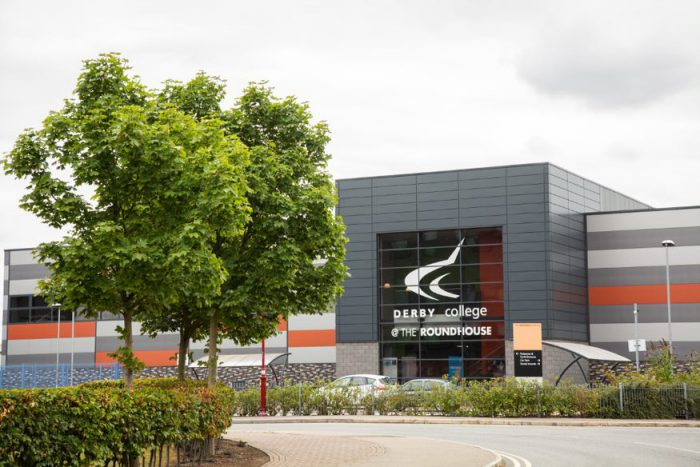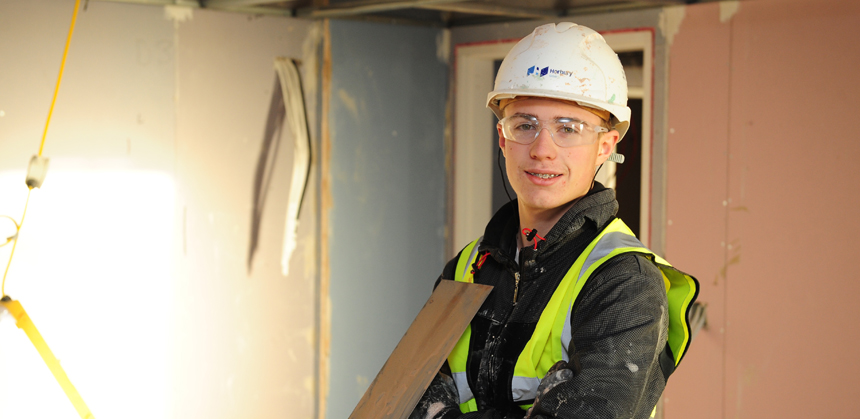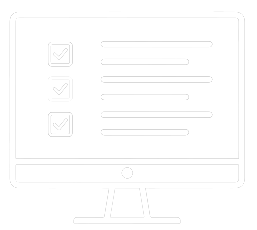Apprenticeship Plasterer Level 2 Standard
This apprenticeship is offered in conjunction with your employer. It will provide training covering the knowledge, skills, behaviours and real practical experiences required to complete a Level 2 apprenticeship standard in plastering, helping ensure you are successful in your future career.
Course Summary

Course Information for Students
Who is this course for?
This apprenticeship is offered in conjunction with your employer. It will provide training covering the knowledge, skills, behaviours and real practical experiences required to complete a Level 2 apprenticeship standard in plastering, helping ensure you are successful in your future career.
Entry Requirements
You should have gained employment as an apprentice with a construction or building company, with the main focus of your role being on plastering techniques.
You will need a minimum of GCSE grade D/3 or above in English and Maths and you will be required to undertake a basic skills test in literacy and numeracy at the College.
A Pass or above in a Construction-based course – or an equivalent qualification – is desirable, although not always required.
A commitment to your own learning and performance in a working environment is essential.
What will you learn?
Please note that the current published content below is subject to change and should only be used for guidance on what may be included in the revised Level 2 apprenticeship.
CORE KNOWLEDGE AND SKILLS REQUIREMENTS
Knowledge
Health and safety: Health and safety hazards, current regulations and legislation. Codes of practice and safe working practices, including asbestos awareness and correct use of personal protective equipment (PPE).
Customer service: The principles of high quality customer service. Establishing the needs of others (colleagues, customers and other stakeholders). Respect the working environment including customers’ properties, impact on other trades and the project.
Communication: Different communication methods. How to communicate in a clear, articulate and appropriate manner. How to adapt communication style to different situations. How to interpret and use drawings and specifications.
Buildings: Different eras, types of construction methods, insulation considerations, facilities, fire protection. The importance of thermal/insulation to buildings, damp proofing/tanking, renovation and restoration.
Materials: Types of traditional and modern materials; moving, handling and storage of them; their uses and characteristics, eg types, condition, strength and compatibility. Cost awareness and environmental considerations/waste awareness eg surface water management and recycling. Chemical damp proofing installation, moisture effects and damage.
Considerations before completing plastering work: u-values, insulation, impact, fire proofing around steel work.
Dry lining: materials, methods and finishes.
Skills
Materials: Identify and prepare surfaces for plastering. Determine quantities and ratios of materials. Move, handle and store materials.
Safe working: Adhere to relevant health and safety legislation, codes of practice and apply safe working practices, including when working at heights.
Working environment: Select appropriate tools, equipment, materials and components where necessary. Interpret and use drawings and specifications. Maintain a clean working area.
Fixing and jointing plasterboard: Mechanically install plasterboard to timber and lightweight metal framing. Direct bond plasterboard to masonry. Use hand applied and machine applied tape and jointing systems.
Plastering: Apply solid plastering systems using one and two coat plastering to internal surfaces.
In-situ moulds: Construct running moulds to match existing moulding design, set up running rules and plaster screeds, run in-situ moulding work including coring out using bracketing on solid backgrounds. Assemble benches, run short breaks and form stop ends, make good internal and external mitres and returned ends.
Running moulds: Construct positive or negative running moulds. Set down running rules correctly. Run reverse moulds and prepare for casting. Run panel moulds. Take casts from reverse moulds.
Repairing existing plaster: Renovate and restore internal and external surfaces back to original state.
Install cast mouldings: Install cornice mouldings including forming internal and external mitred angles.
SPECIFIC KNOWLEDGE AND SKILLS REQUIREMENTS
Apprentices will undertake the core learning above and also specialise in one of the particular disciplines listed below:
Solid plastering
Plastering: Apply three coat plastering, including heritage lime mortars and finishes, and machine applied plaster; re-instate plastering systems after chemical damp proof injection.
Rendering: Apply traditional, modern and machine applied render systems including colour rendering; run in situ moulding work in sand and cement.
Ancillary works: Fix beads and trims, use additives and form mechanical keys as required, mechanically fix EML, riblath and timber lath.
Fibrous plastering
Reverse moulds: Produce reverse moulds (eg enriched cornices, arches, columns, pilasters, corbels ceiling centre and beam case).
Casting: Cast from reverse moulds in fibrous plaster, GRG and GRC (glass fibre reinforced cement)
Fixing cast mouldings: Install cast mouldings (eg enriched cornice, arches, columns, pilasters, corbels, ceiling centre and beam casing.)
Restoration of existing mouldings: Take squeezes of different types of mouldings using plaster, clay and silicone rubber to reproduce mouldings to match the original; produce and install mouldings for the repair of existing mouldings.
BEHAVIOURS
Positive and mature attitude: Conscientious, punctual, enthusiastic, reliable and professional including appearance. Take responsibility for personal judgements and actions. Be aware of the limits of personal competence. Show drive and energy in fulfilling requirements of the role, including deadlines and being proactive not reactive. Show honesty and integrity by developing the trust of customers and colleagues and undertaking responsibilities in an ethical and empathetic manner. Demonstrate awareness of equality and diversity in all aspects of role.
Quality focused: Be reliable, productive, efficient and quality focussed in work and in personal standards to meet current industrial standards. Awareness and consideration of other trades, eg plaster walls in a way that allows for pipes and electrical wiring. Keep work area clean and tidy. Provide protection to adjacent finishes to avoid possible damage. Provide good customer service. Give consideration to the appropriate use of resources and personal actions in regards to environmental, social and economic factors and their impacts.
Effective communication: Oral (including listening), written, body language and presentation. Collaborate with others, eg colleagues, clients, architects, contract managers, other trades, clients, suppliers and the public regardless of differences in race, gender, sexual orientation, or other characteristics.
Self-motivated learner: Identify personal development needs and take action to meet those needs. Keep up to date with best practice and new technology. Show initiative to independently complete work and solve problems by seeking out critical information.
If they have not already achieved them, the apprentice will have to attain Level 1 English and Maths and take the test for Level 2 prior to taking their end-point assessment.
How will you learn?
The apprenticeship will be delivered in the workplace and on-site.
What will you need to bring with you?
Your employer should provide you with Personal Protective Equipment.
How will you be assessed?
The current published content below is subject to change and should only be used for guidance on what may be included in the revised Level 2 apprenticeship.
Summary of Assessment
The End-point Assessment (EPA) will assess how an apprentice can apply skills, knowledge and behaviours acquired in their apprenticeship through the following three assessments. These are carried out at the end of the apprenticeship, after the apprentice has completed the agreed duration of on-programme learning:
- Knowledge test – assessed by an End-point Assessment Organisation (EPAO), this test will consist of multiple-choice questions on a computer-based platform. Provisions can be made for paper-based assessments to be available if reasonable adjustments require this.
- Skills test – assessed over two days by an Independent End-point Assessor (IEPA), this assessment will holistically assess the skills, knowledge and behaviours acquired throughout the apprenticeship.
- Oral questioning – assessed by an IEPA following the skills test, this will confirm the learner’s understanding and obtain further evidence of knowledge. It will extend and amplify the ability demonstrated in the skills test.
The EPA can only be taken after the conditions of the Assessment Gateway have been successfully achieved.
Assessment Gateway:
If they have not already achieved them, the apprentice will have to attain Level 1 English and Maths and take the test for Level 2 prior to taking their end-point assessment.
Where next?
You can progress to supervisory, management or professional and technical courses and qualifications.
Who do you contact for more information?
For more information contact Derby College on 0800 0280289 or enquiries@derby-college.ac.uk
Is there any financial support available?
Course Information for Employers
Apprenticeship summary
This course meets the needs of students who have gained an apprenticeship position in plastering. It allows them to learn, develop and practise the skills required. They will specialise in either solid or fibrous plaster work after undertaking the core learning for their employment.
CORE KNOWLEDGE AND SKILLS REQUIREMENTS
Knowledge
Health and safety: Health and safety hazards, current regulations and legislation. Codes of practice and safe working practices, including asbestos awareness and correct use of personal protective equipment (PPE).
Customer service: The principles of high quality customer service. Establishing the needs of others (colleagues, customers and other stakeholders). Respect the working environment including customers’ properties, impact on other trades and the project.
Communication: Different communication methods. How to communicate in a clear, articulate and appropriate manner. How to adapt communication style to different situations. How to interpret and use drawings and specifications.
Buildings: Different eras, types of construction methods, insulation considerations, facilities, fire protection. The importance of thermal/insulation to buildings, damp proofing/tanking, renovation and restoration.
Materials: Types of traditional and modern materials; moving, handling and storage of them; their uses and characteristics, eg types, condition, strength and compatibility. Cost awareness and environmental considerations/waste awareness, eg surface water management and recycling. Chemical damp proofing installation, moisture effects and damage.
Considerations before completing plastering work: u-values, insulation, impact, fire proofing around steel work.
Dry lining: materials, methods and finishes.
Skills
Materials: Identify and prepare surfaces for plastering. Determine quantities and ratios of materials. Move, handle and store materials.
Safe working: Adhere to relevant health and safety legislation, codes of practice and apply safe working practices, including when working at heights.
Working environment: Select appropriate tools, equipment, materials and components where necessary. Interpret and use drawings and specifications. Maintain a clean working area.
Fixing and jointing plasterboard: Mechanically install plasterboard to timber and lightweight metal framing. Direct bond plasterboard to masonry. Use hand applied and machine applied tape and jointing systems.
Plastering: Apply solid plastering systems using one and two coat plastering to internal surfaces.
In-situ moulds: Construct running moulds to match existing moulding design, set up running rules and plaster screeds, run in-situ moulding work including coring out using bracketing on solid backgrounds. Assemble benches, run short breaks and form stop ends, make good internal and external mitres and returned ends.
Running moulds: Construct positive or negative running moulds. Set down running rules correctly. Run reverse moulds and prepare for casting. Run panel moulds. Take casts from reverse moulds.
Repairing existing plaster: Renovate and restore internal and external surfaces back to original state.
Install cast mouldings: Install cornice mouldings including forming internal and external mitred angles.
SPECIFIC KNOWLEDGE AND SKILLS REQUIREMENTS
Apprentices will undertake the core learning above and also specialise in one of the particular disciplines listed below.
Solid plastering
Plastering: Apply three coat plastering, including heritage lime mortars and finishes, and machine applied plaster; re-instate plastering systems after chemical damp proof injection.
Rendering: Apply traditional, modern and machine applied render systems including colour rendering; run in situ moulding work in sand and cement.
Ancillary works: Fix beads and trims, use additives and form mechanical keys as required, mechanically fix EML, riblath and timber lath.
Fibrous plastering
Reverse moulds: Produce reverse moulds (eg enriched cornices, arches, columns, pilasters, corbels, ceiling centre and beam case).
Casting: Cast from reverse moulds in fibrous plaster, GRG and GRC (glass fibre reinforced cement)
Fixing cast mouldings: Install cast mouldings (eg enriched cornice, arches, columns, pilasters, corbels, ceiling centre and beam casing.)
Restoration of existing mouldings: Take squeezes of different types of mouldings using plaster, clay and silicone rubber to reproduce mouldings to match the original; produce and install mouldings for the repair of existing mouldings.
Are they any entry requirements for my apprentice?
Your apprentice must be able to demonstrate they are working at or above a GCSE grade D/3 standard as a minimum requirement. They must also demonstrate a commitment to the apprenticeship.
What is required from the employer in the workplace?
An apprenticeship standard requires the employer to offer support, training and guidance so that the apprentice can record at least 20% of their time on the programme as training relating to the standard. This includes training both at College and on-site.
The apprentice will be required to build on the skills learnt in College while in the workplace and collect evidence in their portfolio to prove 20% of their time was covered by training before they can take the End-Point Assessment.
Behaviours expected within the role
Positive and mature attitude: Conscientious, punctual, enthusiastic, reliable and professional including appearance. Take responsibility for personal judgements and actions. Be aware of the limits of personal competence. Show drive and energy in fulfilling requirements of role, including deadlines and being proactive, not reactive. Show honesty and integrity by developing the trust of customers and colleagues and undertaking responsibilities in an ethical and empathetic manner. Demonstrate awareness of equality and diversity in all aspects of role.
Quality focused: Be reliable, productive, efficient and quality focussed in work and in personal standards to current industrial standards. Awareness and consideration of other trades, eg plaster walls in a way that allows for pipes and electrical wiring. Keep work area clean and tidy. Provide protection to adjacent finishes to avoid possible damage. Provide good customer service. Give consideration to the appropriate use of resources and personal actions in regards to environmental, social and economic factors and their impacts.
Effective communication: Oral (including listening), written, body language and presentation. Collaborate with others, eg colleagues, clients, architects, contract managers, other trades, clients, suppliers and the public, regardless of differences in race, gender, sexual orientation, or other characteristics.
Self-motivated learner: Identify personal development needs and take action to meet those needs. Keep up to date with best practice and new technology. Show initiative to independently complete work and solve problems by seeking out critical information.
What qualification will my apprentice gain?
- Level 2 Standard in Plastering
- Functional Skills in Maths and English
On completion of this apprenticeship, the apprentice will have satisfied the requirements to obtain a Construction Skills Certification Scheme (CSCS) Card at the appropriate level. As a result of achieving the apprenticeship, there will also be an entitlement to join the Federation of Master Builders’ continuous professional development (CPD) scheme for individual tradespeople.
What will the assessment look like?
The current published content below is subject to change and should only be used for guidance on what may be included in the revised Level 2 apprenticeship.
Summary of Assessment
The End-point Assessment (EPA) will assess how an apprentice can apply skills, knowledge and behaviours acquired in their apprenticeship through the following three assessments. These are carried out at the end of the apprenticeship, after the apprentice has completed the agreed duration of on-programme learning:
- Knowledge test – assessed by an End-point Assessment Organisation (EPAO), this test will consist of multiple-choice questions on a computer-based platform. Provisions can be made for paper-based assessments to be available if reasonable adjustments require this.
- Skills test – assessed over two days by an Independent End-point Assessor (IEPA), this assessment will holistically assess skills, knowledge and behaviours acquired throughout the apprenticeship.
- Oral questioning – assessed by an IEPA following the skills test to confirm the learner’s understanding and to obtain further evidence of knowledge. It will extend and amplify the ability demonstrated in the skills test.
The EPA can only be taken after the conditions of the Assessment Gateway have been successfully achieved.
Assessment gateway:
If they have not already achieved them, the apprentice will have to achieve Level 1 English and Maths and take the test for Level 2 prior to taking their End-point Assessment.
Will my apprentice need to come into college?
Your apprentice will need to come into College at least one day per week during the academic year and in line with term times.
Is there any specialist equipment required?
Your apprentice will need to be equipped with their own PPE such as boots, hi-vis and gloves. Tools will be supplied in College but not in the workplace.
What progression can my apprentice expect after completion of their apprenticeship?
Completion of the Intermediate Apprenticeship may allow the apprentice to progress to supervisory, management or professional and technical courses and qualifications.
What job roles will this apprenticeship be suitable for?
- Maintenance plasterer
- Site plasterer
- Self-employed plasterer
Will the college help me find an apprentice?
You may already have someone in your organisation or someone has come to you direct asking for an apprenticeship, but if you don’t we have a free recruitment service to help you hire the best candidate for your organisation from our talent pool and external advertising through social media and the national apprenticeship services website
Contact us
If you are an employer and you would like to know more, please email businessenquiries@derby-college.ac.uk or call 01332 387421
Career Information
This course could lead to one of these careers...
Plasterers
£31099

DCG Success Stories

Brad Peters
Plastering apprenticeship with Horbury and Derby College is brilliant, says Brad
Like with anything there are some jobs I like more than others. Of course scraping and preparation has to be done first, which no one likes much, but I really enjoy the plastering part. It's quite a skill and involves a lot of attention to detail. I'm also enjoying going to Derby College on day release. The facilities there are great and all the teaching staff are very helpful.
Course Information Last Updated On: October 18, 2023 11:25 am


